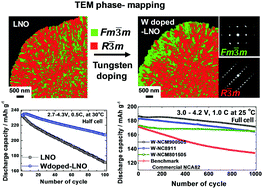Pushing the limit of layered transition metal oxide cathodes for high-energy density rechargeable Li ion batteries†
Abstract
Development of advanced high energy density lithium ion batteries is important for promoting electromobility. Making electric vehicles attractive and competitive compared to conventional automobiles depends on the availability of reliable, safe, high power, and highly energetic batteries whose components are abundant and cost effective. Nickel rich Li[NixCoyMn1−x−y]O2 layered cathode materials (x > 0.5) are of interest because they can provide very high specific capacity without pushing charging potentials to levels that oxidize the electrolyte solutions. However, these cathode materials suffer from stability problems. We discovered that doping these materials with tungsten (1 mol%) remarkably increases their stability due to a partial layered to cubic (rock salt) phase transition. We demonstrate herein highly stable Li ion battery prototypes consisting of tungsten-stabilized Ni rich cathode materials (x > 0.9) with specific capacities >220 mA h g-1. This development can increase the energy density of Li ion batteries more than 30% above the state of the art without compromising durability.



 Please wait while we load your content...
Please wait while we load your content...